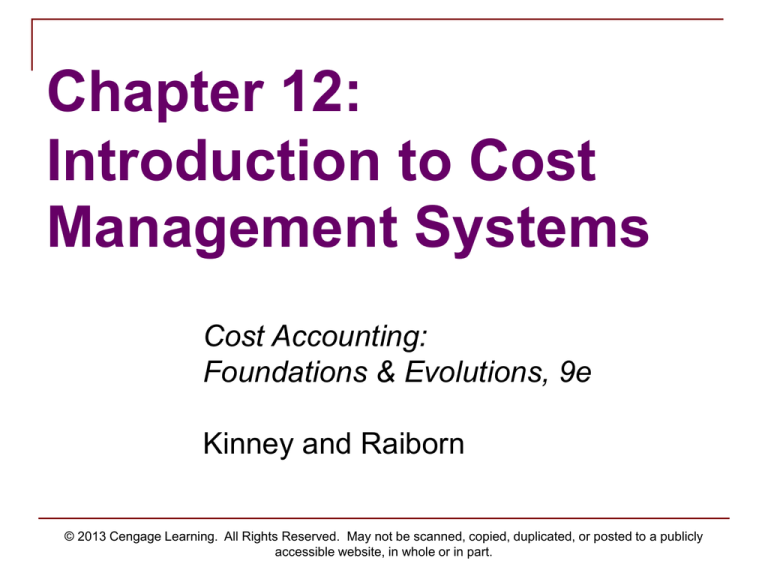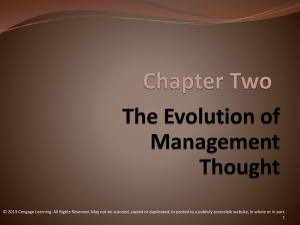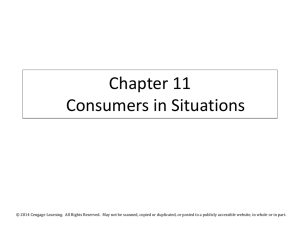
Chapter 12:
Introduction to Cost
Management Systems
Cost Accounting:
Foundations & Evolutions, 9e
Kinney and Raiborn
© 2013 Cengage Learning. All Rights Reserved. May not be scanned, copied, duplicated, or posted to a publicly
accessible website, in whole or in part.
Learning Objectives
Why do organizations have management control systems?
What is a cost management system?
What are the organizational roles of a cost management
system?
What factors influence the design of a cost management
system?
What are the three groups of elements that comprise a
cost management system, and what are the purposes of
these elements?
What is gap analysis, and how is it used in the evolution of
a cost management system?
© 2013 Cengage Learning. All Rights Reserved. May not be scanned, copied, duplicated, or posted to a publicly
accessible website, in whole or in part.
Relationship of Financial, Management,
and Cost Accounting
FINANCIAL
ACCOUNTING
COST
MANAGEMENT
ACCOUNTING ACCOUNTING
© 2013 Cengage Learning. All Rights Reserved. May not be scanned, copied, duplicated, or posted to a publicly
accessible website, in whole or in part.
Cost Accounting
Financial Accounting
Uses cost accounting information for external reporting
Conforms to GAAP
Highly aggregated
Historical
Management Accounting
Uses cost accounting information for internal purposes—
planning, controlling, decision making, and performance
evaluation
Segmented
Current
Relevant for specific purposes
© 2013 Cengage Learning. All Rights Reserved. May not be scanned, copied, duplicated, or posted to a publicly
accessible website, in whole or in part.
Cost Management System (CMS)
Formal methods to plan and control an
organization’s cost-generating activities
with major challenges of
Achieving profitability in the short run
Maintaining a competitive position in the
long run
© 2013 Cengage Learning. All Rights Reserved. May not be scanned, copied, duplicated, or posted to a publicly
accessible website, in whole or in part.
Cost Management System (CMS)
Objective
Focus
Information
Characteristics
Short Run
Organizational
efficiency
Specific costs:
manufacturing,
service, marketing,
administration
Timely,
accurate,
highly specific,
short term
Long Run
Survival
Cost categories:
customers, suppliers,
products, distribution
channels
Periodic,
reasonably accurate,
broad focus
long term
IMA 1998
© 2013 Cengage Learning. All Rights Reserved. May not be scanned, copied, duplicated, or posted to a publicly
accessible website, in whole or in part.
Cost Management System Goals
Develop product costs
Assess product/service life-cycle
performance
Improve understanding of processes and
activities
Control costs
Measure performance
Allow pursuit of organizational strategies
© 2013 Cengage Learning. All Rights Reserved. May not be scanned, copied, duplicated, or posted to a publicly
accessible website, in whole or in part.
Cost Management System Design
The design of the CMS is influenced by
Organizational form, structure, and culture
Organizational mission and core competencies
Operations and competitive environment and
strategies
© 2013 Cengage Learning. All Rights Reserved. May not be scanned, copied, duplicated, or posted to a publicly
accessible website, in whole or in part.
Organizational Form
Choice of form affects
Cost of raising capital
Cost of operating business
Cost of litigating
Statutory authority to make decisions
Forms of the business include
Corporations, Partnerships, LLPs, LLCs
© 2013 Cengage Learning. All Rights Reserved. May not be scanned, copied, duplicated, or posted to a publicly
accessible website, in whole or in part.
Organizational Structure
Distribute authority and responsibility
Group subunits
Centralized or decentralized decision making
Geographically
By similar missions (build, harvest, or hold)
By natural product clusters
Determine accountability for cost
management and organizational control
Determine the information needed by the
decision maker
© 2013 Cengage Learning. All Rights Reserved. May not be scanned, copied, duplicated, or posted to a publicly
accessible website, in whole or in part.
Organizational Culture
Organizational culture is:
An underlying set of assumptions about the
entity and the goals, processes, practices,
and values that are shared by its members
How people interact with each other
The extent to which individuals take
authority and assume responsibility for
organizational outcomes
© 2013 Cengage Learning. All Rights Reserved. May not be scanned, copied, duplicated, or posted to a publicly
accessible website, in whole or in part.
Organizational Mission and
Core Competencies
Business mission regarding competition
Avoid competition
Product Differentiation
Cost Leadership
Confront competition by identifying and exploiting
temporary opportunities
Business mission in relation to product life
cycle
© 2013 Cengage Learning. All Rights Reserved. May not be scanned, copied, duplicated, or posted to a publicly
accessible website, in whole or in part.
Organizational Core Competencies
Critical core competencies
Timeliness
Quality
Customer service
Efficiency and cost control
Responsiveness to change
The cost management system
gathers data related to measurement of these items
collects external intelligence on competitor performance in
competency areas
tracks performance in competency areas through time
reports about core competencies in a useful format
© 2013 Cengage Learning. All Rights Reserved. May not be scanned, copied, duplicated, or posted to a publicly
accessible website, in whole or in part.
Operations and Competitive
Environment and Strategies
Management needs to assess:
Cost structure, including the proportion of fixed and
variable costs
Level of technology costs, which tends to be fixed
and not susceptible to short-run control
Production capacity
Flexibility to respond to a change in short-term
conditions
© 2013 Cengage Learning. All Rights Reserved. May not be scanned, copied, duplicated, or posted to a publicly
accessible website, in whole or in part.
CMS Elements
Motivational elements
Information elements
Reporting elements
© 2013 Cengage Learning. All Rights Reserved. May not be scanned, copied, duplicated, or posted to a publicly
accessible website, in whole or in part.
Implement CMS
Gap Analysis
Identify gap to overcome
Prioritize differences
Develop and deploy improvements
Repeat process to ensure continuous
improvement
© 2013 Cengage Learning. All Rights Reserved. May not be scanned, copied, duplicated, or posted to a publicly
accessible website, in whole or in part.
Enterprise Resource Planning
For a truly integrated CMS
Standardize information systems/replace
legacy systems
Automate and integrate transfer of data among
systems
Improve the quality of information
Improve timeliness of information
Real-time, on-line reporting
© 2013 Cengage Learning. All Rights Reserved. May not be scanned, copied, duplicated, or posted to a publicly
accessible website, in whole or in part.
Questions
Why do companies have
management control systems?
How does the external operating
environment affect the cost
management system?
What is gap analysis?
© 2013 Cengage Learning. All Rights Reserved. May not be scanned, copied, duplicated, or posted to a publicly
accessible website, in whole or in part.
Potential Ethical Issues
Using the financial accounting system rather
than a cost management system to support
management functions
Not balancing long- and short-run concerns in
the design of the cost management system
Using motivational elements to create high
payoffs for fraudulent behavior
Designing motivational elements that donot
align with manager’s authority
© 2013 Cengage Learning. All Rights Reserved. May not be scanned, copied, duplicated, or posted to a publicly
accessible website, in whole or in part.







